Blog
May 28th, 2011
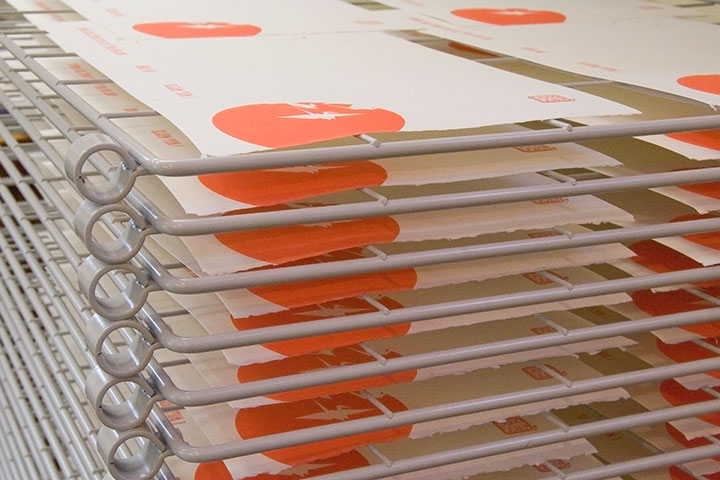
I’m still not sure how it happened, but it’s May already—and that means Jessica and I are due for another broadside. This weekend, while everyone else is grilling hot dogs, we’re cooking up something entirely different. Now, if only print racks left behind those tasty-looking grill marks…
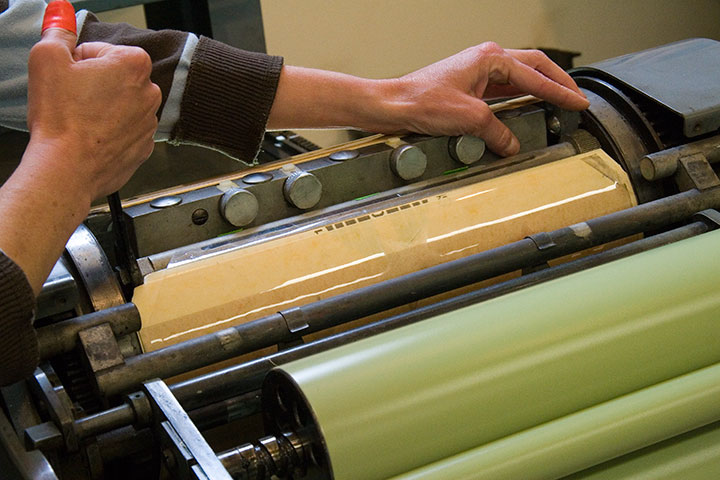
Memorial Day has a little bit of a part to play in the new piece, so we’ll be unveiling it here on Monday.
In the meantime, have a safe and happy holiday weekend (and to all our friends outside the U.S., a safe and happy regular weekend!). See you soon.

April 12th, 2011

Jessica and I have locked ourselves in her studio with an armful of Talking Heads records (go, portable turntable!) and some very sharp knives. Don’t worry about us, though—it’s just an annual tradition here in T-town.
That’s because this Sunday is the seventh annual Wayzgoose, that crazy letterpress block party that draws hordes, flocks, gaggles of people to King’s Books for some seriously huge fun. And we’ll be polishing up our street cred with the main event—steamroller printing. We’ll be pounding that pavement come rain or shine (please, pray for shine), so stop by and check it out!
7th Annual Wayzgoose
Sunday, April 17, 2011
11 am to 4 pm, Free!
King’s Books
218 St. Helens Ave., Tacoma, WA
Near the top of a very long list of things I love about Tacoma is the sheer number of people here who know what the heck a Wayzgoose is. If you haven’t experienced ours yet for yourself, you’re in for a treat. Meet a whole host of local and regional artists; shop a huge array of letterpress art and gifts; make your own books and posters; and don’t forget to bring a t-shirt! The D.I.Y. screen printing booth will back by popular demand, and this year, some of the street-printing artists (including yours truly) are going to have bite-sized versions of their steamroller designs ready to be made into t-shirts. I know what I’ll be wearing this weekend.
Speaking of which … Jessica and I don’t want to ruin the surprise, so we’re keeping our design under wraps for now. But let’s just say that this year we’ll be getting our feathers ruffled—
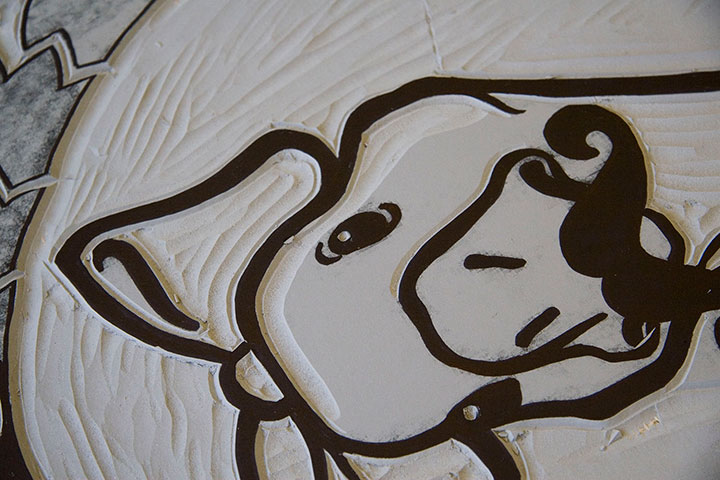
—and breaking out the ‘stache wax.
See you Sunday!
March 5th, 2011
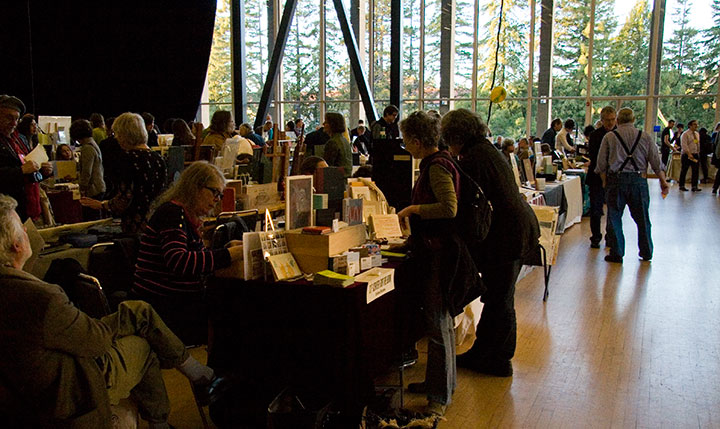
You know, I spent the whole time I was at Codex just trying to process everything around me. I thought the few weeks since that I’ve been telling stories and rehashing memories would make it easier to sort it out in my mind, but I still just can’t seem to articulate the impressions bouncing around the inside of my skull.
It was just too big … too rich … too much.
Which probably explains why I never managed to get any decent photos. I was too busy standing there goggling at the enormity of it all to document the experience properly. It was all I could do just to man my own table and keep track of all the folks who stopped by to talk to me.

Let me backtrack a bit, and explain what all of this was about. For every discipline, subculture or interest group out there, there’s some sort of club, or society, or conference, or symposium, or bee, or knitting night, or comicon, or hot-dog-eating contest, or what-have-you—some organized gathering for like-minded people to get together and share what they do. If you can think of it, there’s probably a group of people meeting about it somewhere.
The trouble with the book arts is that our world is small and spread out. There aren’t too many of us who do this sort of thing in the first place, at least when compared to photographers, or children’s book writers, or web developers. And then within our little group, everybody follows such a different path that getting us together is like herding cats. We’re hard to pin down because there’s a whole universe in our little speck of dust. Printing, bookbinding, papermaking and typesetting are just the tip of the iceberg. Within each of those disciplines is an incredibly broad spectrum of different and often contradictory artists and art forms. And yet each of those fits comfortably, easily, infinitely under the same, paradoxically small umbrella of the book arts. (Now you know why I’m not great at elevator speeches.) If you tried to graph it out, you’d end up with either the world’s best or worst Venn Diagram—I can’t decide.
So because we run such a crazy gamut, we can’t be shoehorned in neatly with some other event, even though the “average” book artist can and probably does moonlight quite easily as a dozen other things. There’s no “book arts corner” at SXSW, or BlogHer, or the Venice Biennale. Exhibitions and summits dedicated entirely to the book arts are few and far between—large international events are rare, indeed. So for our lot, Codex is a big deal.
This year there were over 140 exhibitors at the book fair, representing artists in every conceivable discipline and style, and every corner of the globe. The exhibitors hailed from 20 states and over a dozen countries outside the U.S., including Russia, Germany, France, Israel, Colombia, Japan, Mexico and Canada.
And it isn’t just for artists: students, educators, private collectors, librarians, museum curators, conservators and archivists, hobbyists, publishers, supply vendors, gallery reps and dealers, bookstore owners, clubs and organizations, and every stripe of enthusiast were in attendance.
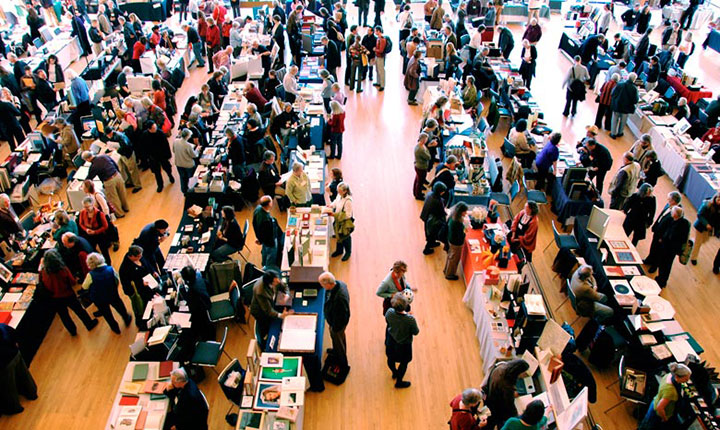
Photo courtesy of the Codex Foundation.
So yeah. Codex is huge.
It was both intimidating and inspiring. I was immediately and constantly confronted with my own insignificance (I kept imagining that at any moment, some cartoon alarm would go off—woop! woop! woop!—alerting everyone to the fact that I didn’t belong there)—yet at the same time, everyone I met was warm and welcoming.
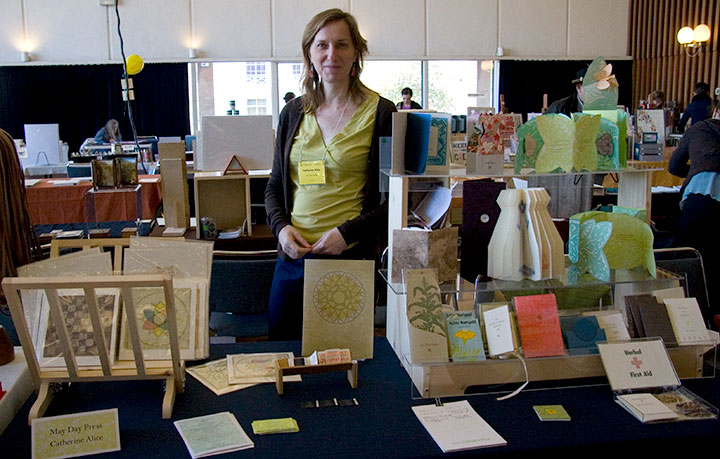
I had the chance to catch up with old friends, meet many of my long-admired art-heroes, and be introduced to a whole host of new faces.
But most of all, Codex was completely, utterly overwhelming. I had my brain cranked up into overdrive for four solid days. After meeting literally hundreds of people, answering thousands of questions, asking another thousand myself, handling many dozens of handmade books and artworks, absorbing new information and taking copious notes, and just being exposed to the ultimate sensory overload of it all—well, by the end, I was a deer in the headlights.
And I feel like I barely scratched the surface of what was there. Imagine that you’re visiting the Louvre, or the Smithsonian, or some other enormous museum. Only instead of picking and choosing which galleries and pieces to see, and making your way through room by room, you discover that every painting, every sculpture, every piece of art in the whole place is crammed into one huge hall—each with the artist who made it standing to the side, waiting to meet you and hear what you think. I’d go mad—I think I did go mad!
Everything I saw was phenomenal—it was hard not to just stand there, slack-jawed, struck dumb by the realization that there I was, in close proximity to some of the best work being done by anyone, anywhere.
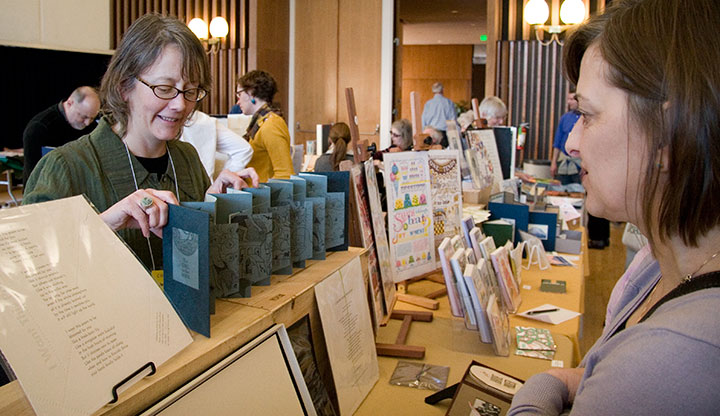
I could go on and on. And I’m sure there were a thousand other great things I never had a chance to see, because I also had a table to man. Jessica and I made the trip together (that’s her showing one of her books), and as we had adjacent tables—
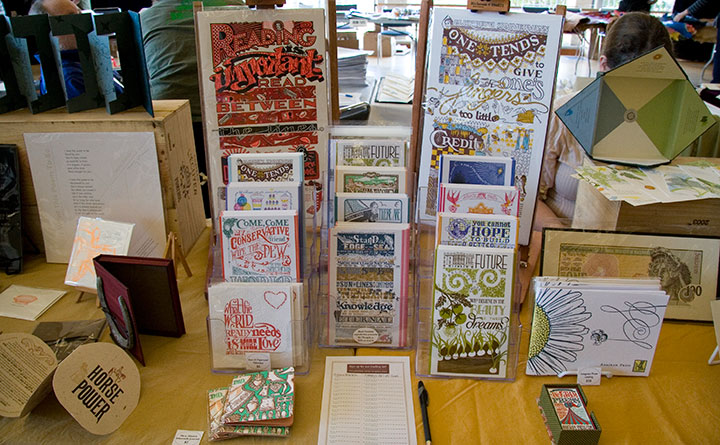
—we met in the middle with our Dead Feminists stuff between us.
Jessica’s done Codex once before, so she was prepared for the overwhelming onslaught of people. She suggested that we put together a letterpress-printed take-away catalog of our work so that after the fair, when everyone was just as dazed as I was, they’d have something to remember us by. (And that ended up being a great idea, and a big hit—we had tons of follow-up messages afterward, and we didn’t see anything like the catalog at the book fair.)
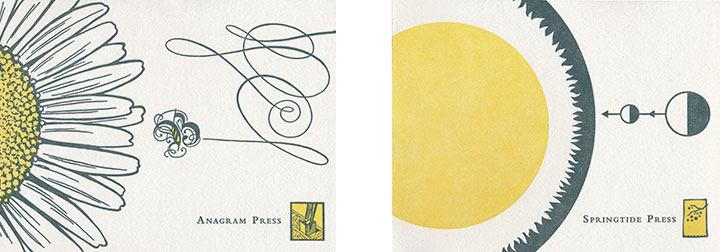
Since we collaborate on so many things, we decided to combine our efforts into one joint catalog—with a twist.
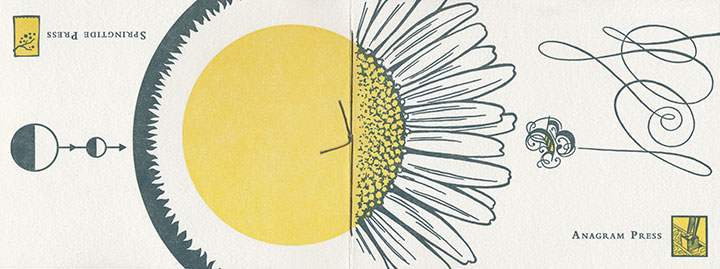
We figured we had an opportunity to clear up a little of the confusion over who does what around here, so we had fun playing with the design possibilities. Jessica came up with a flip-flop format, and I designed two covers that would come together at the spine to form a single image if laid flat.
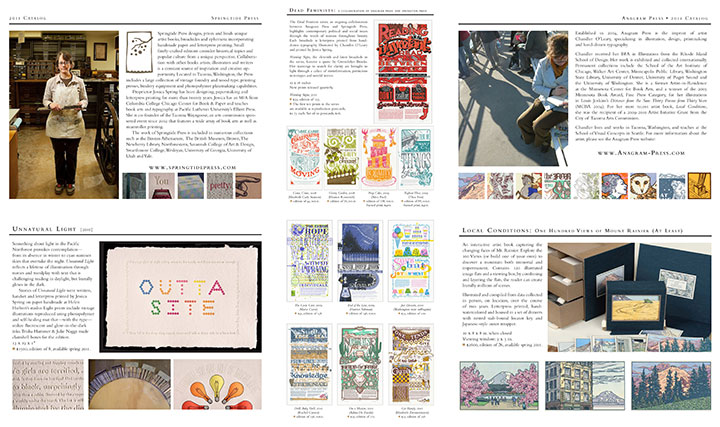
Held one way, you’d read her half of the catalog; flip it over and read from the back, and it becomes my half. We converged in the middle with a Dead Feminist “centerfold” (ha!).

For my part, the most gratifying part of Codex was watching a steady crowd playing with Local Conditions. The response people had to the book was both intensely gratifying and humbling—and it was wonderful to see that students, fellow artists, dealers, curators, professors and collectors were equally excited about it. But my favorite bit was being a bystander to all the different scenes people designed with the image flats.
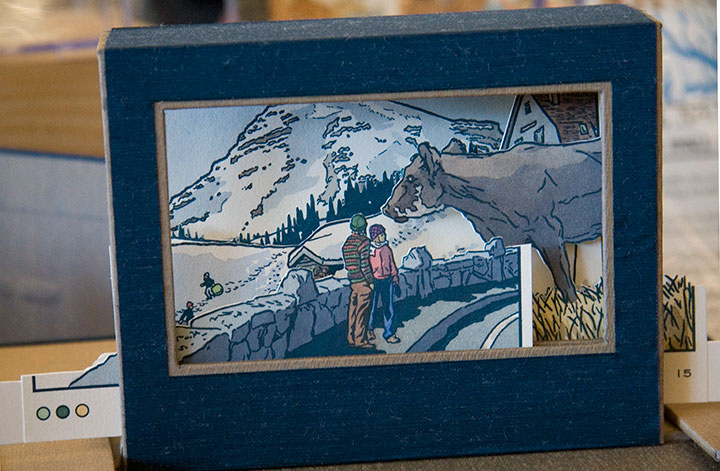
The cow completely stole the show there. It was hilarious to see how many times it turned up in a scene, either a fitting addition I hadn’t thought of—or as an absurdly out-of-place monster.
(Best of all was the cow that stood on the airplane wing and pretended to be a gremlin.)
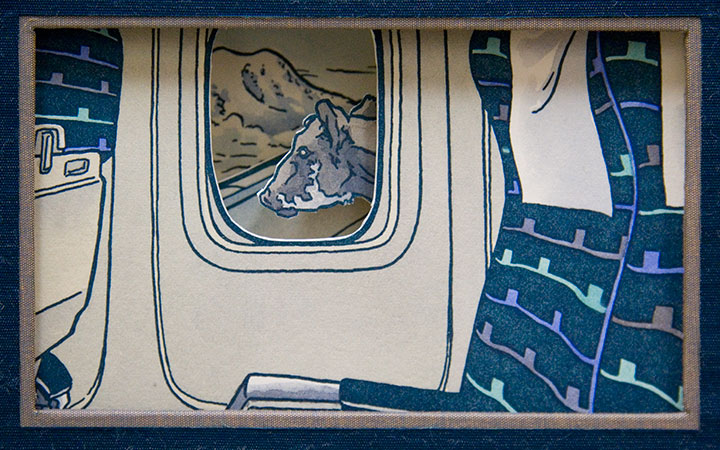
It’s hard to remember that we were in a city as fabulous as Berkeley—the folks at Codex had created a complete world just in that one room. (Though we did get out enough to discover that when the overstimulation had us in a daze, a hot-cookie ice cream sandwich down the street was just the ticket. Thank you, Berkeley!) The next fair is two years away, but I came home with what seemed like a decade’s worth of inspiration. And I find I’m already looking forward to Codex 2013—sensory overload and all.
Bring it on. I’ll be there.

February 18th, 2011
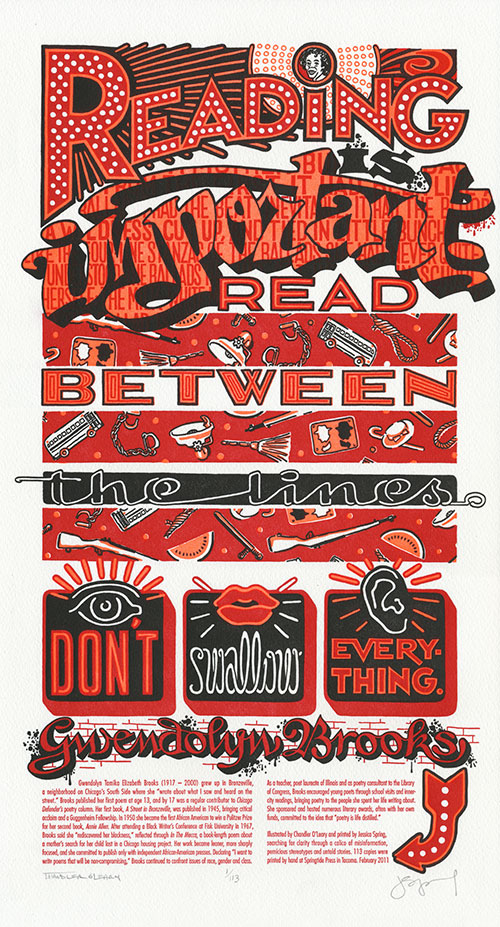
In honor of Black History Month, and of the might of the written word, our newest Dead Feminist is powerhouse poet Gwendolyn Brooks. Without further ado, I’ll hand over my pen to her:
Reading is important. Read between the lines. Don’t swallow everything.
I guess we’re done with the knitting needles and home canning for now; time to don the boxing gloves. This was a tough one, and we almost didn’t have the gall to go through with it. But Gwendolyn Brooks was never one to pull a punch; she faced and shed light on the most uncomfortable truths with bravery and eloquence. And there seem to be an awful lot of uncomfortable truths floating around lately; like a certain congressperson’s assertion that our nation’s founding fathers ended slavery, or the fact that no matter how many African American Presidents we elect, racism isn’t dead. (Don’t believe me? Even my most cursory historical research brought up all sorts of fresh, modern hatred. Try it for yourself and do an online image search for “watermelon stereotype”—if you can stomach it. Just keep an airsick bag handy, because it ain’t pretty.)
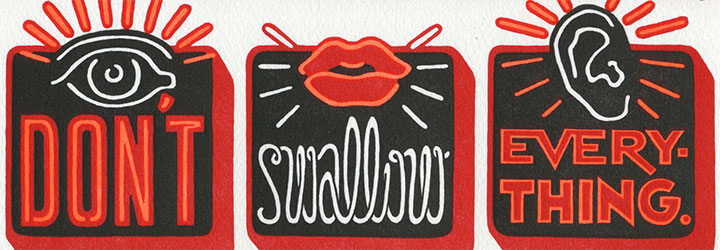
So in tribute to Brooks’s courage, Warning Signs is a riot of color and fluorescent ink, glowing like an urban beacon. Flashing neon and spattered graffiti confront us, sounding the alarm with every word. Beneath the fluorescent current runs a blood-red repeating calico pattern of violence and cruelty—a tapestry that forms the unfortunate warp to the weft of our past and present.

And as an undercurrent to the undercurrent, behind the graffiti reads the first stanza of Brooks’s poem, “A Bronzeville Mother Loiters in Mississippi. Meanwhile, a Mississippi Mother Burns Bacon.” The poem grapples with the brutal 1955 murder of 14-year-old Emmett Till, and weaves a tale of remorse and confusion from the perspective of Carolyn Bryant, the white woman whose accusations that Till flirted with her provoked her husband to abduct and kill the boy. But we didn’t choose the poem for its subject matter, per se—we chose it for the articulate beauty with which Brooks tells the story. It’s still a punch to the gut, but when she knocks you flat you see some awfully pretty stars.
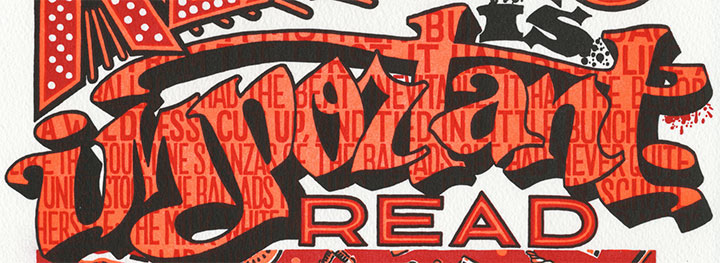
A portion of the proceeds from Warning Signs will be donated to 826CHI, a non-profit Chicago writing and tutoring center. 826CHI is dedicated to supporting the writing skills of students ages 6 to 18, and to helping teachers inspire their students to write—their mission is to “strengthen each student’s power to express ideas effectively, creatively, confidently, and in his or her individual voice.” We think Ms. Brooks would approve.
• • • • • • • • • • • • • • • • • • • • • • • • • • • • • • • • • • • • • • • • • • • • • • • • • • • • • • • • • • • •
Warning Signs: No. 11 in the Dead Feminists series
Edition size: 113
Poster size: 10 x 18 inches
Printed on an antique Vandercook Universal One press, on archival, 100% rag paper. Each piece is numbered and signed by both artists.
Colophon reads:
Gwendolyn Tamika Elizabeth Brooks (1917 – 2000) grew up in Bronzeville, a neighborhood on Chicago’s South Side where she “wrote about what I saw and heard on the street.” Brooks published her first poem at age 13, and by 17 was a regular contributor to Chicago Defender’s poetry column. Her first book, A Street in Bronzeville, was published in 1945, bringing critical acclaim and a Guggenheim Fellowship. In 1950 she became the first African American to win a Pulitzer Prize for her second book, Annie Allen. After attending a Black Writer’s Conference at Fisk University in 1967, Brooks said she “rediscovered her blackness,” reflected through In The Mecca, a book-length poem about a mother’s search for her child lost in a Chicago housing project. Her work became leaner, more sharply focused, and she committed to publish only with independent African-American presses. Declaring “I want to write poems that will be non-compromising,” Brooks continued to confront issues of race, gender and class.
As a teacher, poet laureate of Illinois and as poetry consultant to the Library of Congress, Brooks encouraged young poets through school visits and inner-city readings, bringing poetry to the people she spent her life writing about. She sponsored and hosted numerous literary awards, often with her own funds, committed to the idea that “poetry is life distilled.”
UPDATE: poster is sold out. Reproduction postcards available in the Dead Feminists shop!

February 17th, 2011

After thirteen days and 2,382 miles on the road, I’m finally home in the real world again. And that’s exactly how it feels—like I’ve been in a land of make-believe for the past two weeks. A place of impossible landscapes and endless shorelines and absolutely no connection to things like phones and computers and deadlines and to-do lists.
Now that I’ve washed back ashore, however, there are photos to edit and sketches to scan before I can tell you about it. In the meantime, Jessica and I have a schedule to keep: as advertised, our next Dead Feminist broadside is back from Codex and ready to share. Look for it here and in the shop tomorrow.
See you then!
November 10th, 2010
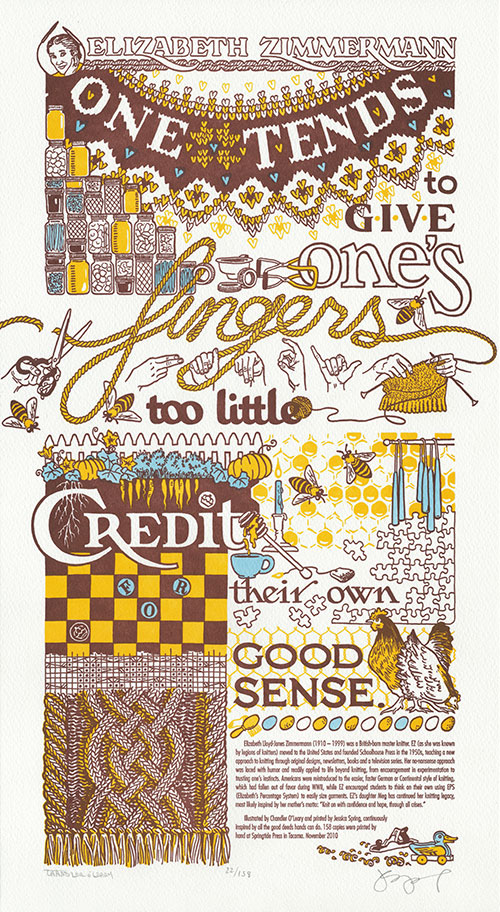
Maybe it’s the changing seasons. Or the fact that the farmers market runneth over with delicious autumn goodies. Or maybe we just wanted to talk about something that made us smile, for a change—because this time, for our tenth Dead Feminist broadside, Jessica and I have turned to a subject somewhat lighter of heart.
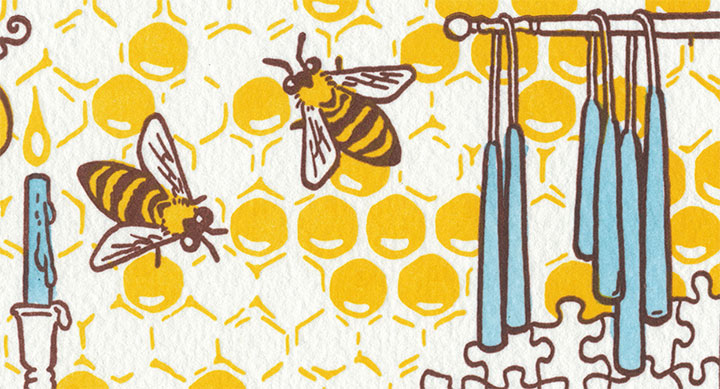
From the likes of urban homesteaders, artisans, D.I.Y.-ers, and hobbyists of all stripes, brilliant handiwork is all around us. We are in constant admiration of the power of one’s own two hands, and the good deeds they can do. And for the perfect symbol of a handmade life infused with joy and meaning, we’ve handed the microphone to Elizabeth Zimmermann:
One tends to give one’s fingers too little credit for their own good sense.

Now, as many of you probably know, Ms. Zimmermann was a knitter (that’s an understatement; I’d say more like All-Time Super-Queen Knitter of the Cosmos, Forever and Ever, Amen). But like every knitter, there is so, so much more to her than that. So rather than simply leaving it at yarn and wool, we discovered a cornucopia of the pursuits that fingers like to turn to when they’re not knitting. There are no idle hands here, to be sure.

Just in time for the fall harvest and in cozy preparation for the winter months ahead (or for our friends in the southern hemisphere, looking forward to a fruitful summer), Get Handy overflows with simple pleasures and home comforts. Elizabeth drafts a cable pattern and whips up a Fair Isle yoke. A little slow food takes root in the garden. Honeybees guard a new crop of candles. Fresh home-canned treats stock the shelves. Chickens scratch along a fence of golden (darning) eggs. Over a cup of tea, puzzles piece together and checkers crown kings. And when they’ve put down the yarn and scissors, the hands spell it out for you in American Sign Language.
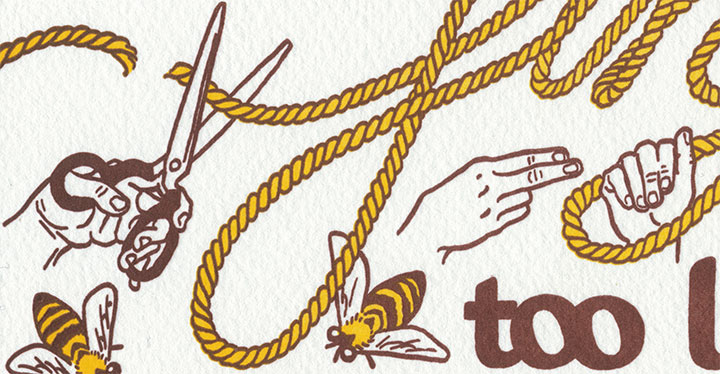
Oh, and the Tailor’s blueberries and Jessica’s dilly beans make a cameo appearance. Yum.

A portion of the proceeds from Get Handy will be donated to the amazing healing hands of Médecins Sans Frontières / Doctors Without Borders, via Tricoteuses Sans Frontières / Knitters Without Borders, which organizes knitters to raise funds for MSF/DWB. MSF, winner of the 1999 Nobel Peace Prize, is a medical relief organization dedicated to assisting people in distress around the world.
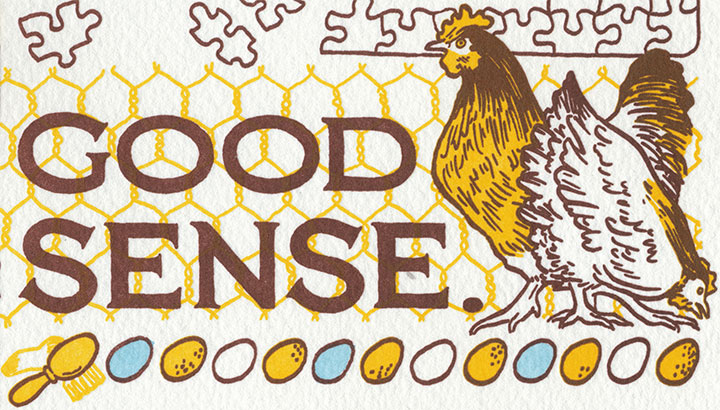
• • • • • • • • • • • • • • • • • • • • • • • • • • • • • • • • • • • • • • • • • • • • • • • • • • • • • • • • • • • •
Get Handy: No. 10 in the Dead Feminists series
Edition size: 158
Poster size: 10 x 18 inches
Printed on an antique Vandercook Universal One press, on archival, 100% rag paper. Each piece is hand-colored and signed by both artists.
Colophon reads:
Elizabeth Lloyd-Jones Zimmermann (1910 – 1999) was a British-born master knitter. EZ (as she was known by legions of knitters) moved to the United States and founded Schoolhouse Press in the 1950s, teaching a new approach to knitting through original designs, newsletters, books and a television series. Her no-nonsense approach was laced with humor and readily applied to life beyond knitting, from encouragement in experimentation to trusting one’s own instincts. Americans were reintroduced to the easier, faster German or Continental style of knitting, which had fallen out of favor during WWII, while EZ encouraged students to think on their own using EPS (Elizabeth’s Percentage System) to easily size garments. EZ’s daughter Meg had continued her knitting legacy, most likely inspired by her mother’s motto: “Knit on with confidence and hope, through all crises.”
UPDATE: poster is sold out. Reproduction postcards available in the Dead Feminists shop!

November 9th, 2010
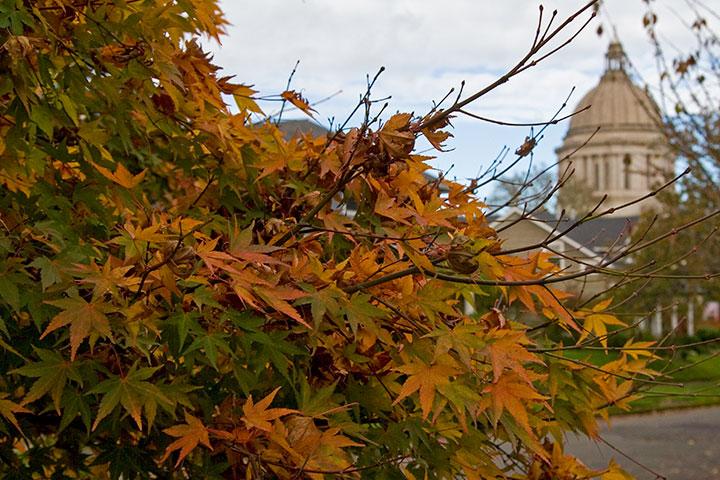
I woke up this morning after the first full night’s sleep in over a month, and celebrated by breaking the recent routine of studio-studio-studio entirely. I ignored the computer, bundled up, and headed down to the state capitol in Oly for a once-in-a-century party.

One hundred years ago today, the state of Washington approved an amendment to the state constitution granting women the right to vote.
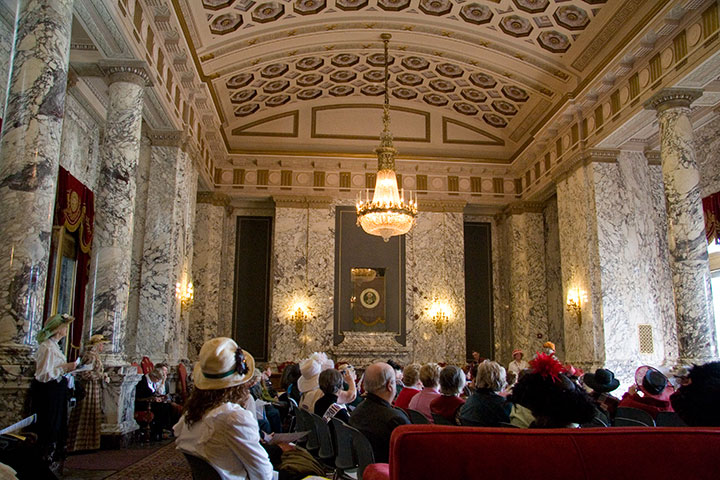
To celebrate the occasion, the capitol rotunda played host to the Centennial Day of Jubilation. Forget collaborating on Jell-o recipes; I think even May and Emma would have agreed on how cool an idea this was.
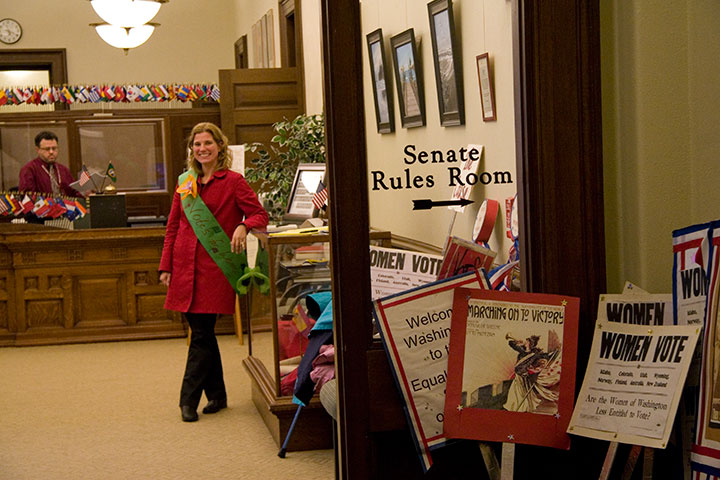
Everyone in the Rotunda got in on the action. The Lieutenant Governor’s office, here, was transformed into a picket line,

while reenactors turned the foyer into a debate chamber.
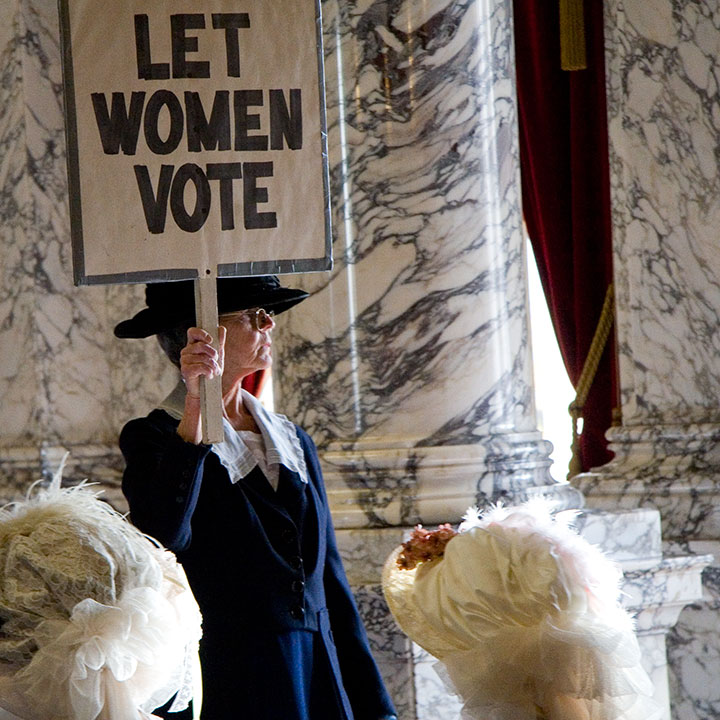
And upstairs, in the Reception Room, a feisty demonstrator channeled the spirit of the suffragists—

and did her best to drag the audience into the past with her.
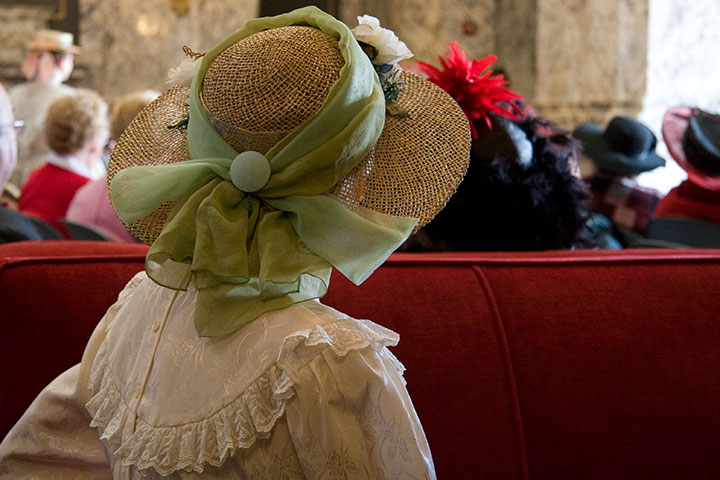
It’s too bad I don’t own any Edwardian clothing—I felt a bit underdressed for the occasion.
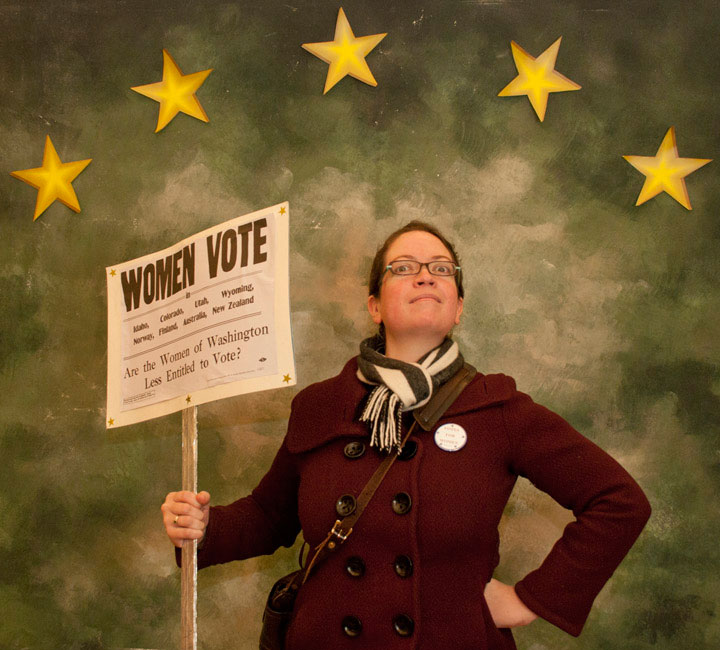
Still, I managed to channel my inner suffragist, even without the corset and bustle.

And on my twenty-first century overcoat, I found a way to wear a little pride. In my head I did a little thank-you salute to all the Washington suffragists of old. Ladies, we couldn’t celebrate without you.
October 22nd, 2010
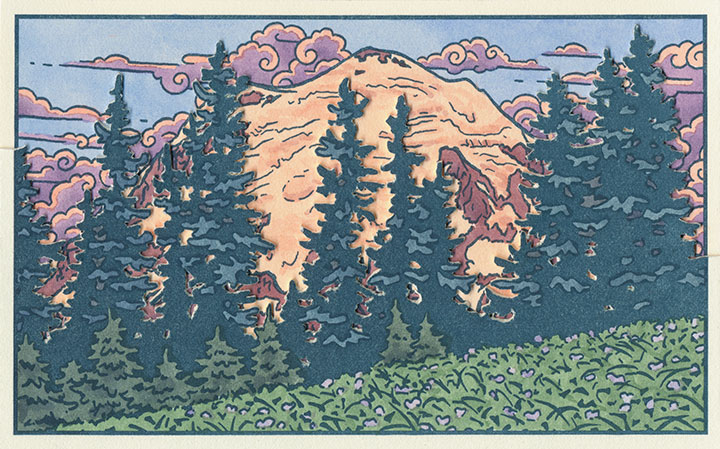
It’s getting harder and harder to keep the secret these days—the Rainier book is almost done, and I’m just dying to show you. But I don’t want to ruin the surprise for T-town, so I’m going to keep it under my hat for just a little longer. But after over two years of being under wraps, the book is gussying it up and stepping out for a solo exhibition. Here’s a brief description of what you’ll see:
Local Conditions, an interactive artist book, captures the changing faces of Mt. Rainier. Explore the 100 Views—or create one of your own—to discover a mountain both immortal and impermanent.
The book contains 120 image flats and a viewing box; by combining and layering the flats, the reader can create literally millions of scenes. Images are illustrated and compiled from data collected in person, on location, over the course of two years. Letterpress printed, watercolored, and hand-bound in an edition of 26 books. Sponsored by the Tacoma Arts Commission.
Exhibit runs November 4 through January 21
Collins Memorial Library, University of Puget Sound, Tacoma, WA
Opening reception: Thursday, November 4, 4:30 to 6:30 p.m.
Artist talk (sponsored by the Book Arts Guild): Thursday, November 11, 7 p.m., Room 020
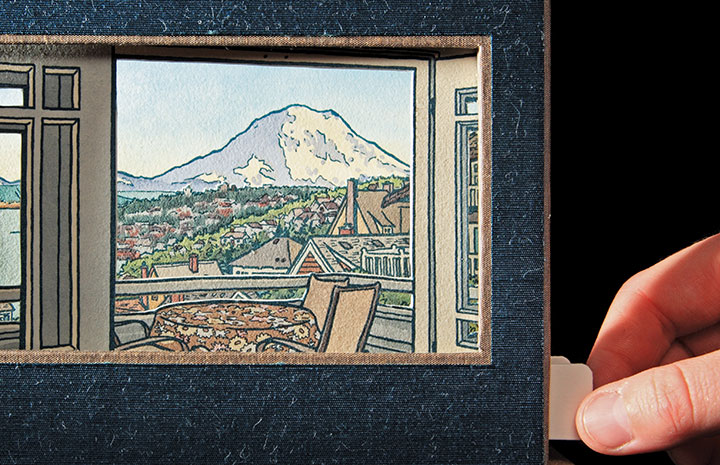
Photo by Sarah Christianson
If you miss the exhibition opening, I’ll have some of the process materials from the book out for perusal at this year’s Studio Tour—as well as the brand new Dead Feminist broadside! (Look for it online in early November.) So be sure to stop by!
Saturday and Sunday, November 6 and 7
Open 10 am to 4 pm.
More information, maps, addresses and directions can be found here.
See you then!
October 16th, 2010
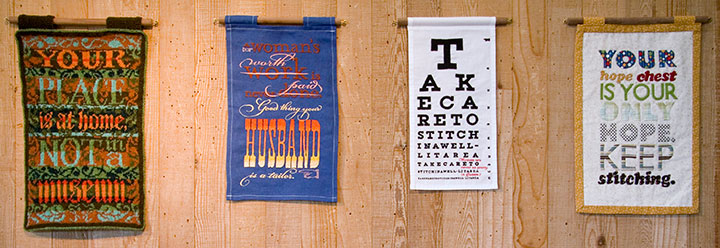
By now you’ve figured out that I have a thing for stitched lettering; and since I’ve already rambled on ad nauseum in the last post, I can keep this one a little shorter.
And anyway, I somehow neglected to take any process photos for two of these. Oops.

The knitted broadside was such a success that I decided to try branching out into other textile media. For Broadside No. 4, I took a shot at appliqué—something I’d never done before. Hand-sewing all those fiddly little pieces of fabric ended up being just as daunting as cutting a steek.
The hard work was oddly fitting for the concept: historically, a traditional wedding trousseau would have been sewn by a girl or young woman, in hopes of one day becoming a married woman with a home of her own. By the time she reached young adulthood, a woman would have spent years creating dozens of hand-sewn garments, household linens and other useful textiles, all gathered and stored in her “hope chest,” awaiting the day she would become a bride.

The thing is, back in the days when women couldn’t vote, or own property, or head a household, marriage was a woman’s only shot at independence or social status. (Hence the snark.)
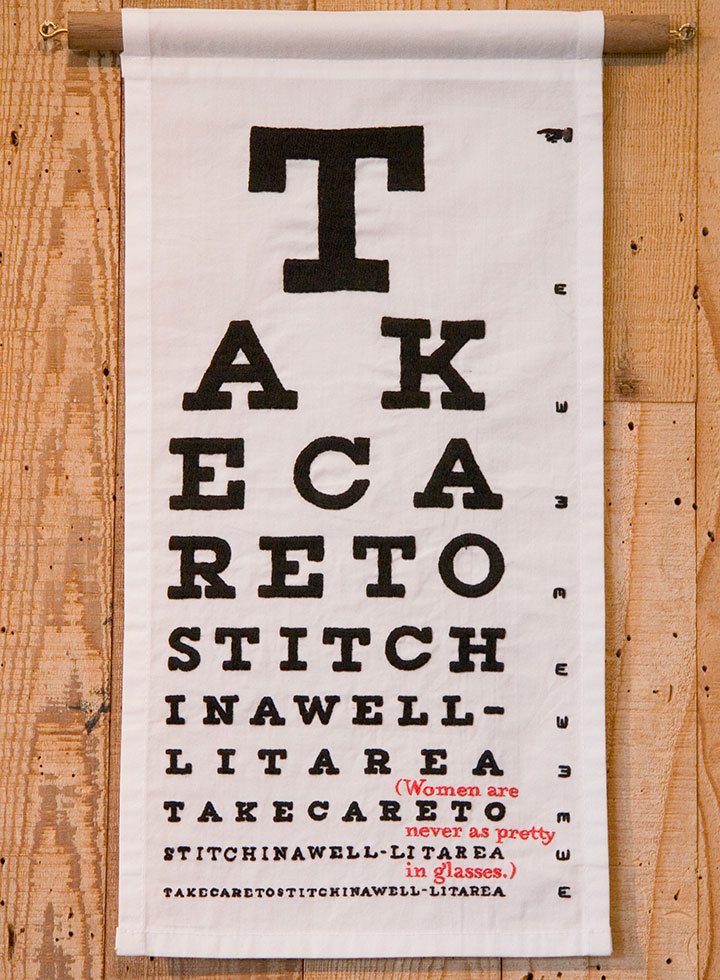
For the others, I turned to the original, old-school ancestor of fabric paint: embroidery. The method fit the madness this time, too, as I spent what seemed like a century hunched over and squinting, hand-stitching an eye chart…
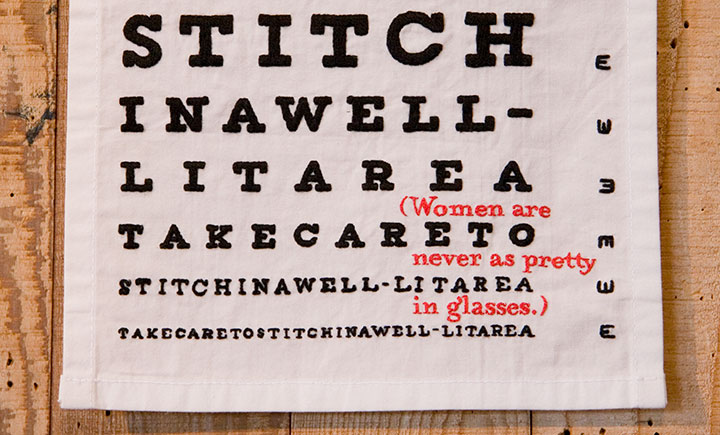
…complete with something to read between the lines.
This one gets personal. As a glasses-wearing gal myself, I happen to disagree with the statement—but I’ve actually heard these very words spoken by a woman. She wasn’t wearing glasses.

Last of all, I got to thinking about how men who sew for a living are called tailors—and women who do the same are called seamstresses. And how the two terms don’t quite add up to the same meaning.

Despite what the scornful quipping of the text might indicate, I had the most gleeful fun with this one. Unlike knitting, which confines the designer to a grid, or appliqué, which can only push the detailing so far, embroidery has almost limitless possibilities. So I went nuts with the tails and ligatures and dingbats, simply because I could. I love that about embroidery—it’s as flexible as I need it to be, and as fluid and crisp as the printed page.
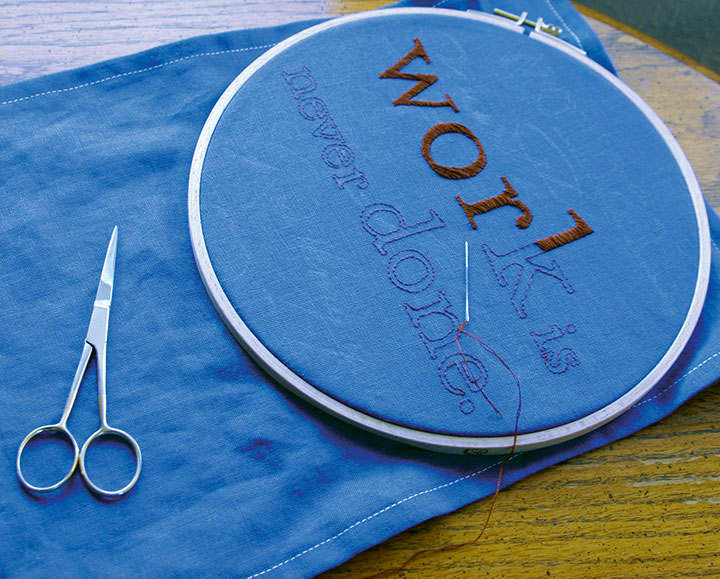
All that was required was the patience to work each letter by hand. But it didn’t feel like patience—it felt like meditation.

It’s surprising how easy it is for embroidery to mimic letterpress. And watching “wood” type pop up from the fabric, rather than punch into paper, is a mighty satisfying sight.

Uppity notions aside (no pun intended), the Women’s Work broadsides are a fun way to slow down and take a break from what I normally do in the studio. But as I wrap up each one, I find myself hankering to get back into the print shop. By comparison, setting type and drawing letters suddenly seems like speedy work!
October 11th, 2010
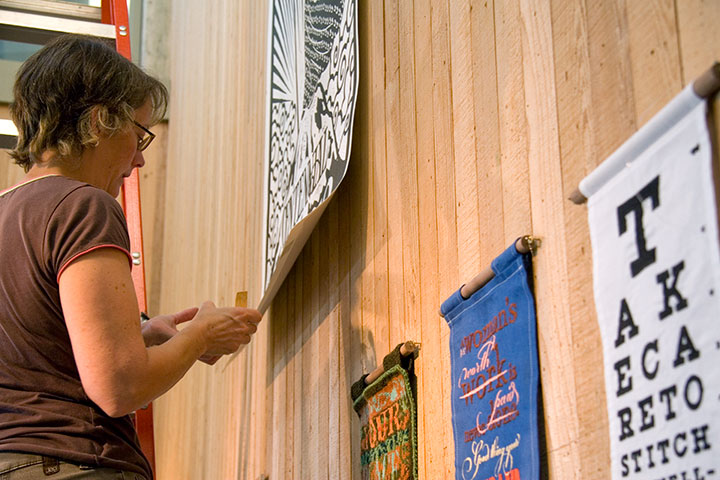
While I’ve been hiding away, wrangling my 900-pound gorilla, Jessica has been cooking up something pretty great.
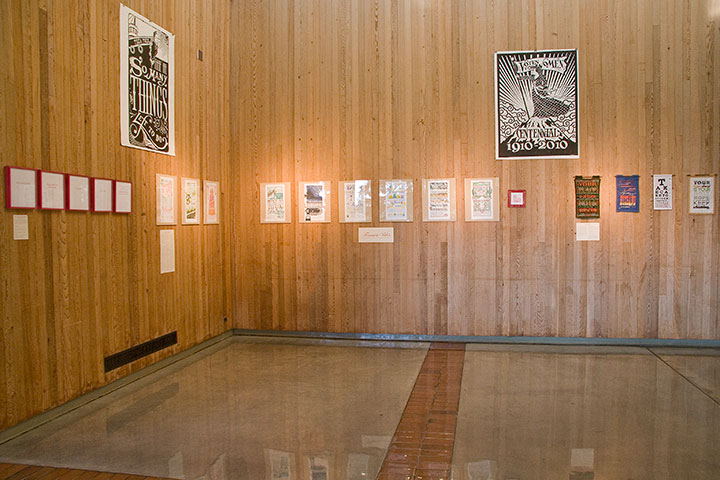
Thanks to her hard work and the wonderful Brian Hutcheson‘s invitation, we are pleased as punch to announce our first-ever dual exhibition!
Feminist Wiles: Jessica Spring and Chandler O’Leary
Now through November 5
Ted Sanford Gallery, Charles Wright Academy
7723 Chambers Creek Rd. W
Tacoma, Washington
Open 8 to 5, Monday through Friday
It seems weird that after more than two years of collaborating, giving lectures and printing in the street, we’ve never had an honest-to-goodness show together.
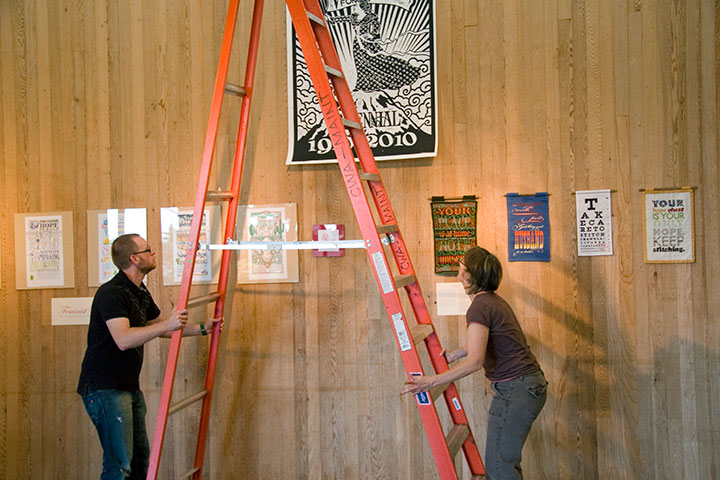
But when Brian offered us a cavernous space, his help with installation, and the chance to indoctrinate the innocent introduce our series to the kids at Charles Wright—well, we’d be nuts to pass that up.
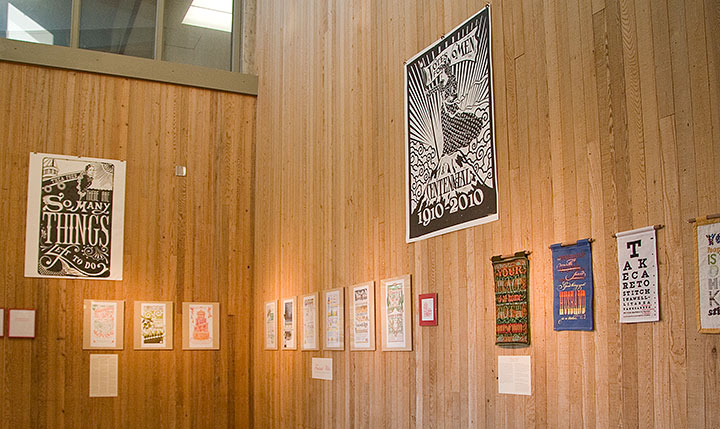
For the first time, all nine (and-a-half) Dead Feminist broadsides to date, plus our two steamroller gals, are on display together.
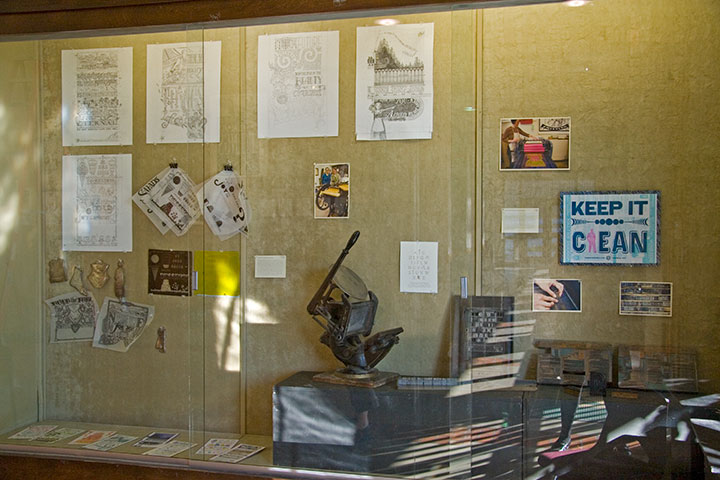
We also have a little mini-exhibit about our process,

and lots of little goodies to introduce people to letterpress.
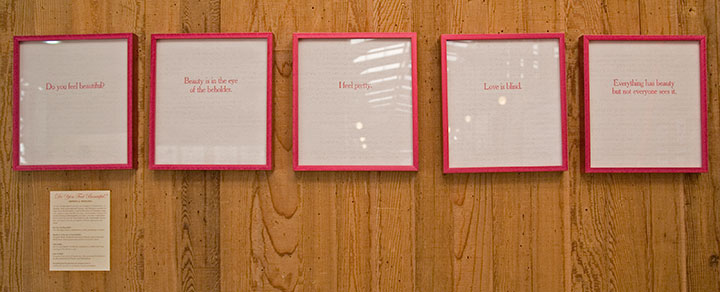
Jessica and I have rounded out the collection with solo work that complements the theme of the show. Jessica’s half consists of Do You Feel Beautiful?, a series of broadsides featuring famous aphorisms on beauty. Here’s the thing that blows my mind into tiny pieces every time I think of it: the quotes are letterpress printed on the pages of a Braille edition of Seventeen magazine. Whoa.
I contributed Women’s Work, an ongoing series of broadsides created in hand-sewn textiles rather than my usual letterpress.
Now, I get a ton of questions about these things whenever I show them, so I thought I’d outline the ideas and process behind them here.

The Tailor first sparked the idea for the series; as you know, he makes his own clothing (hence the nickname). This is a feat that never ceases to amaze me, and I’m not the only one—he gets a lot of comments, usually along the lines of “Wow, you made that?” He’s always a little surprised by these comments, because where he grew up, a lot of people (including his family) wore homemade clothing. That got me thinking, though. The people who do all that sewing in the Tailor’s hometown are women—mothers, grandmothers, sisters, daughters, wives. We’re all surrounded and preceded by generations of women who sew clothing, or knit sweaters, or draft patterns from scratch, without any rave reviews—or any comment at all. But every male knitter or quilter I’ve known, every rare and wonderful man who ever picked up a needle, is either looked at like he’s nuts, or treated with reverent awe. It strikes me as a little strange that depending on who made it, and who’s looking at it, a pair of pants can be a work of art—and an actual work of art can be completely ignored.
If you go further back, like, I dunno, throughout the entirety of human history—you’ll find that both men and women have been responsible for creating textile goods in nearly every culture on earth. Yet in almost every case, when men made textiles it was as part of some sort of guild craft or other professional setting. When women made textiles, it was as part of the home front. This is true in every part of the globe, in pretty much every era, going back to the advent of textile technology.
No matter who does the stitching, there’s an enormous amount of technical skill and design sensibility required to make a garment or textile object. So instead of creating divisions and pigeonholes—instead of separating into Art and Not Art, into Man-made and Woman-made, what if we started seeing the inherent worth in the objects themselves? And what happens when we take a handmade textile and stick it in a gallery? Does its perception change?
Based on what I’ve seen so far with these broadsides, I’d say it does. It’s been an interesting experiment, for sure.
So the Women’s Work series is a bit of an indictment of the double standard, and while the snark is aimed at a wider target, I wrote them as if I were speaking to a woman. Each one is completely made/knitted/sewn/pieced/embroidered/etc. by hand, from design to pattern to construction. The text reads in the voice of a disapproving female role model (or the insidious voice inside our own heads)—in the tone of the backhanded compliment, the cheerful put-down. Each is also designed in the style of a traditional letterpress broadside, to put the typography within the context of an art form centered around mass communication.

This guy requires a little more of an explanation for folks who aren’t already into wool.

This piece, made almost three years ago now, is hand-knitted with Shetland wool, using the traditional Fair Isle knitting technique. Fair Isle—a method practiced since the nineteenth century on the tiny island of the same name, halfway between Scotland and Norway—is a tricky, rather ingenious thing. Traditional Fair Isle pieces are knit with two colors of yarn at the same time; the resulting fabric is durable, extremely warm, and great for any chilly, foggy, wet climate (like, hello, here). Beyond its über-practicality, Fair Isle knitting is simply gorgeous (take a gander at Google). By nature the double-thick fabric is dense and flat, making it an ideal ground for complex patterns and designs—it’s the perfect mix of function and fancy.
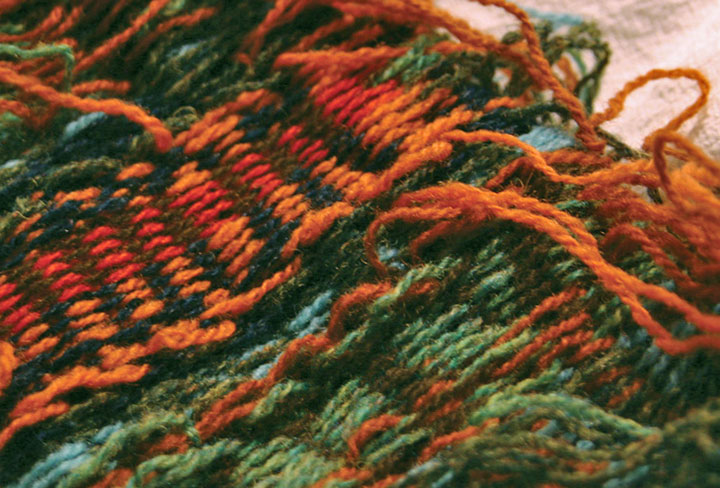
Here’s how it works: even though the piece is knitted with two different colors of yarn at once, only one strand at a time ever passes through the needles. The unused strand of yarn is carried loosely, or “floated,” behind the work—which creates a reversed-out image of the design on the back of the piece. It’s the floats that give structure to the fabric, and make it so cozy-warm.
If you were to create a plain ol’ piece of ordinary knitting, you’d proceed from one end to the other of a row, flip the piece over, and work back the other direction. Rinse and repeat. If you tried that with a piece of Fair Isle knitting, working the “wrong” side would be extremely difficult, since the floats would now be facing you and covering your stitches. Now comes the tricky, smarty-pants part. Flat Fair Isle pieces are first knitted up into a big round tube, and then cut to lie flat. When you knit in the round, you never encounter the wrong side of the work. You just spiral around and around on the right side, happily knitting away and floating the unused color behind you as you go.
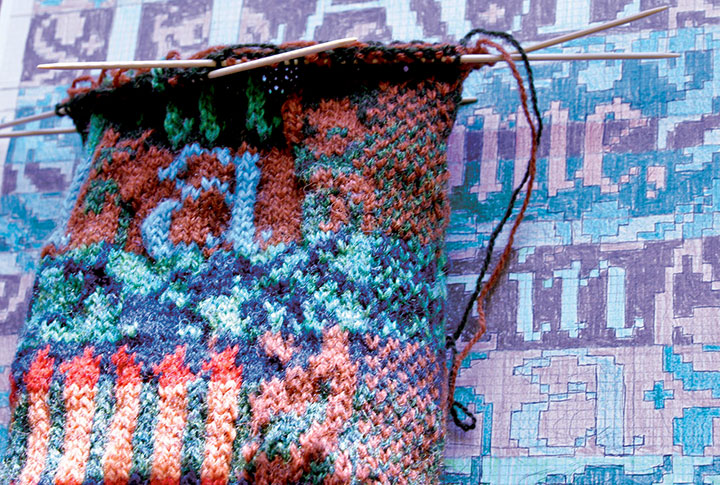
So in this case, once I had drafted my design into a gridded stitch pattern, I just pretended I was knitting one really big sleeve (or a neck warmer for a giraffe) with really teeny needles.
Ah, but remember the operative words above: you have to cut the piece to finish it. I had never done this before, and let me tell you, there’s an awful, terrifying finality to the idea. Torn sweaters unravel. Snagged socks fall apart. Who in their right mind would cut a piece of knitting on purpose? And even if you could do it, what happens if you make a mistake? Once you make that cut, you’re done.
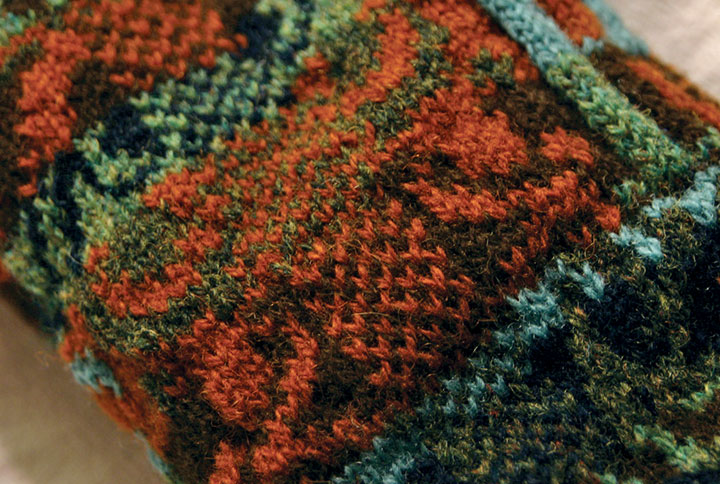
This is where the true brilliance of the technique hit me like a ton of bricks. The Scotswomen of Fair Isle are a breed apart—and so are their sheep. Shetland wool, the material traditionally used in Fair Isle knitting, has a magical property that makes this crazy notion work: each wool fiber is covered with microscopic scales that attach to one another. Because the wool sticks to itself, the stitches become slightly matted as you knit. So following the Fair Isle method, you work a little buffer zone called a steek (see the checkerboard strip above?) into your design, and then cut right down the center of the steek. If you use trusty Shetland wool, your stitches won’t unravel when you cut them.
At least, that was the theory. I didn’t quite believe it at the time. But I’d come this far—I didn’t want to lose faith. (If you’re looking to try Fair Isle knitting yourself, I find a glass of wine helps.) So I took a steadying swig, held my breath, and cut.
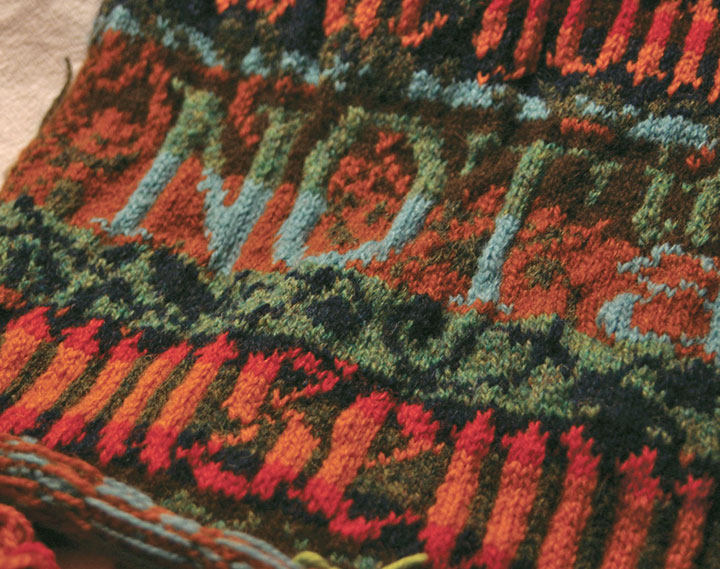
And then I exhaled. And blinked. I had a flat piece. Gingerly I tested the cut edge—and was amazed. Even with a fair bit of tugging, the stitches refused to unravel.
I will never question a Scotswoman again.
My favorite thing about all of this, beyond the magic of Fair Isle itself, is that knitting really lends itself well to letterforms. Even though the pattern is drafted out on a grid, the forgiving nature of knitted stitches turns every square on the grid into a slightly curved, irregular shape. So when you zoom out and look at the piece from a distance, those grid “pixels” turn into nice little serifs, curves and curlicues.
The rest of the broadsides in the series are made using other types of needlework (more on that in the next post), but the knitted piece is still my favorite. I think I need another dose of that Fair Isle magic in my life—maybe next year you’ll find me up to my knees in wool again.
(Read about the rest of the “Women’s Work” broadsides in part two.)


![Chandler O'Leary [logo]](https://chandleroleary.com/wp-content/themes/chandleroleary/images/logo.png)



































































